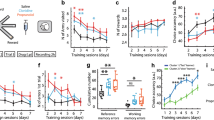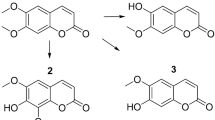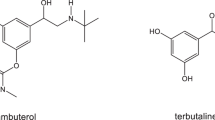Abstract
This study examined the effects of β-adrenergic and muscarinic blockade on spatial learning and strategy use in the water maze. Male Long-Evans rats received systemic injections of propranolol (PRO; 10 or 20 mg/kg) or scopolamine (SCO; 0.3 or 1.0 mg/kg) either singly or in combination. To separate strategies learning from spatial learning approximately half of the rats underwent water maze strategies pretraining prior to drug administration and spatial training. PRO did not impair performance in any group. SCO impaired naive but not pretrained rats. PRO and SCO given together in high doses impaired all aspects of behavior in both naive and pretrained rats, and caused sensorimotor disturbances in some groups. PRO (10 mg/kg) and SCO (0.3 mg/kg) together caused a specific spatial reversal learning impairment in pretrained rats without causing strategies impairments or sensorimotor disturbances. Nadolol administered with SCO failed to produce the same impairments as PRO, suggesting that PRO produced its effects by acting on central nervous system sites. These results point to a greater than additive impairing effect of PRO and SCO on adaptive behavior, and a specific role for β-adrenergic and cholinergic systems working in conjunction in spatial learning. They also suggest that some of the behavioral and cognitive impairments seen in Alzheimer patients or patients receiving pharmacotherapy with β-adrenergic antagonists in which cholinergic activity is also compromised may result from the combined impairment of β-adrenergic and cholinergic systems.
Similar content being viewed by others
Log in or create a free account to read this content
Gain free access to this article, as well as selected content from this journal and more on nature.com
or
References
Angrini M, Leslie JC, Shephard RA (1998). Effects of propranolol, buspirone, pCPA, reserpine, and chlordiazepoxide on open-field behavior. Pharm Biochem Behav 59: 387–397.
Bannerman DM, Good MA, Butcher SP, Ramsay M, Morris RGM (1995). Distinct components of spatial learning revealed by prior training and NMDA receptor blockade. Nature 378: 182–186.
Beaudet A, Descarries L (1978). The monoamine innervation of rat cerebral cortex: synaptic and non-synaptic axon terminals. Neuroscience 3: 851–860.
Beiko J, Candusso L, Cain DP (1997a). The effect of nonspatial water maze pretraining in rats subjected to serotonin depletion and muscarinic receptor antagonism: a detailed behavioural assessment of spatial performance. Behav Brain Res 88: 201–211.
Beiko J, Lander R, Hampson E, Cain DP (1997b). An examination of the relationship between sex differences in spatial performance and plasma corticosterone levels in the rat. Abstr Canad Soc Brain Behav Cog Sci 8: 17.
Booze RM, Crisostomo EA, Davis JN (1989). Species differences in the localization and number of CNS beta-receptors: rat versus guinea pig. J Pharm Exp Ther 249: 911–920.
Bowen DM, Francis PT (1990). Neurochemistry, neuropharmacology and aetiological factors in Alzheimer's disease. Neuroscience 2: 101–108.
Cain DP (1997). Prior non-spatial pretraining eliminates sensorimotor disturbance and impairments in water maze learning caused by diazepam. Psychopharmacology 130: 313–319.
Cain DP (1998). Testing the NMDA, long-term potentiation and cholinergic hypotheses of spatial learning. Neurosci Biobehav Rev 22: 181–193.
Cain DP, Inghanian K, Boon F (2000). Individual and combined manipulation of muscarinic, NMDA, and benzodiazepine receptor activity in the water maze task: implications for a rat model of Alzheimer dementia. Behav Brain Res 11: 125–137.
Cain DP, Saucier D, Boon F (1997). Testing hypotheses of spatial learning: the role of NMDA receptors and NMDA-mediated long-term potentiation. Behav Brain Res 84: 179–193.
Cain DP, Saucier D, Hall J, Hargreaves EL, Boon F (1996). Detailed behavioral analysis of water maze acquisition under APV or CNQX: contribution of sensorimotor disturbances to drug-induced acquisition deficits. Behav Neurosci 110: 86–102.
Cain DP, Saucier D, Hargreaves EL, Wilson E, DeSouza JFX (1993). Polypropylene pellets as an inexpensive reusable substitute for milk powder in the Morris water maze. J Neurosci Methods 49: 193–197.
Decker MW, Gill MT, McGaugh JL (1990). Concurrent muscarinic and β-adrenergic blockade in rats impairs place-learning in a water maze and retention of inhibitory avoidance. Brain Res 513: 81–85.
DeDeyn PP, Rabheru K, Rasmussen A, Bocksberger JP, Dautzenberg PLJ, Eriksson S et al (1999). A randomized trial of risperidone, placebo, and haloperidol for behavioral symptoms of dementia. Neurology 53: 946–955.
Dringenberg HC (2000). Alzheimer's disease: more than a ‘cholinergic disorder’—evidence that cholinergic—monoaminergic interactions contribute to EEG slowing and dementia. Behav Brain Res 115: 235–249.
Fairburn G, Hope RA (1988). Changes in behaviour in dementia: a neglected research area. Br J Psychiatry 152: 406–407.
Giarcovich S, Enero MA (1984). Decreased brain serotonergic activity after acure propranolol. Eur J Pharmacol 100: 123–125.
Hagan JJ, Tweedie F, Morris RGM (1986). Lack of task specificity and absence of posttraining effects of atropine on learning. Behav Neurosci 100: 483–493.
Hardy J, Adolfsson R, Alafuzoff I, Bucht G, Marcusson J, Nyberg P et al (1985). Transmitter deficits in Alzheimer's disease. Neurochem Int 7: 545–563.
Harley CW, Sara SJ (1992). Locus coeruleus bursts induced by glutamate trigger delayed perforant path spike amplitude potentiation in the dentate gyrus. Exp Brain Res 89: 581–587.
Haroutunian V, Santucci AC, Davis KIL (1990). Implications of multiple transmitter system lesions for cholinomimetic therapy in Alzheimer's disease. Prog Brain Res 84: 333–346.
Hoh T, Beiko J, Boon F, Cain DP (1999). Complex behavioral strategy and reversal learning in the water maze without NMDA receptor-dependent long-term potentiation. J Neurosci 19, RC2 1–5.
Holscher C (1999). Stress impairs performance in spatial water maze learning tasks. Behav Brain Res 100: 225–235.
Kolb B, Whishaw IQ (1985). Earlier is not always better: behavioral dysfunction and abnormal cerebral morphogenesis following neonatal cortical lesions in the rat. Behav Brain Res 17: 25–43.
Kobayashi M, Ohno M, Yamamoto T, Watanabe S (1995). Concurrent blockade of B-adrenergic and muscarinic receptors disrupts working memory but not reference memory in rats. Physiol Behav 58: 307–314.
McAinsh J, Cruickshank JM (1990). Blockers and central nervous system side effects. Pharmacol Ther 46: 163–197.
McCormick DA (1992). Neurotransmitter actions in the thalamus and cerebral cortex and their role in neuromodulation of thalamocortical activity. Prog Neurobiol 39: 337–388.
Miller CA (1995). Medications that may cause cognitive impairment in older adults. Geriatric Nursing 16: 47.
Morris RGM (1989). Synaptic plasticity and learning: selective impairment in rats and blockade of long term potentiation in vivo by the N-methyl-D-aspartate receptor antagonist AP5. J Neurosci 9: 3040–3057.
Morris RGM, Anderson E, Lynch GS, Baudry M (1986). Selective impairment of learning and blockade of long-term potentiation by an N-methyl-D-aspartate receptor antagonist, AP5. Nature 319: 774–776.
Nilsson OG, Strecker RE, Daszuta A, Bjorklund A (1988). Combined cholinergic and serotonergic denervation of the forebrain produces severe deficits in a spatial learning task in the rat. Brain Res 453: 235–246.
Richter-Levin G, Segal M (1989). Spatial performance is severely impaired in rats with combined reduction of serotonergic and cholinergic transmission. Brain Res 477: 404–407.
Rogers TV, Bowman CE (1990). Cognitive impairment associated with β-blockade in the elderly. Postgrad Med J 66: 1050–1052.
Sachdev PS, Sabaror T (1997). The effects of b-adrenoreceptor antagonists on a rat model of neuroleptic-induced akathisia. Psychiatr Res 72: 133–140.
Sara SJ, Dyon-Laurent C, Herve A (1995). Novelty seeking behavior in the rat is dependent upon the integrity of the noradrenergic system. Cog Brain Res 2: 181–187.
Saucier D, Cain DP (1995). Spatial learning without NMDA receptor-dependent long-term potentiation. Nature 378: 186–189.
Saucier D, Hargreaves EL, Boon F, Vanderwolf CH, Cain DP (1996). Detailed behavioral analysis of water maze acquisition under systemic NMDA or muscarinic antagonism: nonspatial pretraining eliminates spatial learning deficits. Behav Neurosci 110: 103–116.
Schenk F, Morris RGM (1985). Dissociation between components of spatial memory in rats after recovery from the effects of retrohippocampal lesions. Exp Brain Res 58: 11–28.
Schiff AA, Saxey A (1984). Autoradiography of nadolol and propranolol in the rat. Xenobiotica 14: 687–691.
Sutherland RJ, Whishaw IQ, Regehr JC (1982). Cholinergic receptor blockade impairs spatial localization by use of distal cues in the rat. J Comp Physiol Psychol 96: 563–573.
Teri L, Larson EB, Reifler BV (1988). Behavioral disturbance in dementia of the Alzheimer's type. J Am Geriatr Soc 36: 1–6.
Vanderwolf CH (1987). Near-total loss of ‘learning’ and ‘memory’ as a result of combined cholinergic and serotonergic blockade in the rat. Behav Brain Res 23: 43–57.
Vanderwolf CH (1991). Anti-muscarinic drug effects in a swim-to-platform test: dose–response relations. Behav Brain Res 44: 217–219.
Vanderwolf CH, Baker G (1996). The role of brain noradrenaline in cortical activation and behavior: a study of lesions of the locus coeruleus, medial thalamus and hippocampus–neocortex and of muscarinic blockade in the rat. Behav Brain Res 78: 225–234.
Westerlund A (1985). Central nervous system side-effects with hydrophilic and lipophilic β-blockers. Eur J Clin Pharmacol 28: 73–76.
Whishaw IQ (1989). Dissociating performance and learning deficits on spatial navigation tasks in rats subjected to cholinergic muscarinic blockade. Brain Res Bull 23: 347–358.
Whishaw IQ, Cassel JC, Jarrard LE (1995). Rats with fimbria-fornix lesions display a place response in a swimming pool: a dissociation between getting there and knowing where. J Neurosci 15: 5779–5788.
Whishaw IQ, Jarrard LE (1995). Similarities vs differences in place learning and circadian activity in rats after fimbria-fornix section or ibotenate removal of hippocampal cells. Hippocampus 5: 595–604.
Whishaw IQ, Jarrard LE (1996). Evidence for extrahippocampal involvement in place learning and hippocampal involvement in path integration. Hippocampus 6: 513–524.
Whishaw IQ, Tomie JA (1987). Cholinergic receptor blockade produces impairments in a sensorimotor subsystem for place navigation in the rat: evidence from sensory, motor, and acquisition tests in a swimming pool. Behav Neurosci 101: 603–616.
Acknowledgements
Supported by a grant to DPC and by a postgraduate scholarship to AS from the Natural Sciences and Engineering research Council of Canada.
Author information
Authors and Affiliations
Corresponding author
Rights and permissions
About this article
Cite this article
Saber, A., Cain, D. Combined β-Adrenergic and Cholinergic Antagonism Produces Behavioral and Cognitive Impairments in the Water Maze: Implications for Alzheimer Disease and Pharmacotherapy with β-Adrenergic Antagonists. Neuropsychopharmacol 28, 1247–1256 (2003). https://doi.org/10.1038/sj.npp.1300163
Received:
Revised:
Accepted:
Published:
Issue date:
DOI: https://doi.org/10.1038/sj.npp.1300163
Keywords
This article is cited by
-
A neurochemical yin and yang: does serotonin activate and norepinephrine deactivate the prefrontal cortex?
Psychopharmacology (2011)
-
Combined but not Individual Administration of β-Adrenergic and Serotonergic Antagonists Impairs Water Maze Acquisition in the Rat
Neuropsychopharmacology (2008)
-
Propranolol blocks chronic risperidone treatment-induced enhancement of spatial working memory performance of rats in a delayed matching-to-place water maze task
Psychopharmacology (2007)



